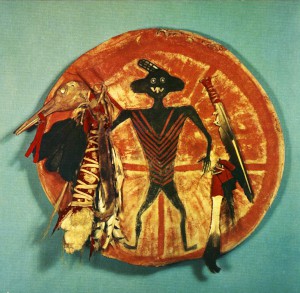 Usually, the moon is personified in myths as a female deity, but it is also known in some cultures as a male figure. Lunar symbolism brings together powers associated with the cyclical patterns in nature: the tide, the fertility cycle of a woman, the shedding of the snake’s skin. All of these repetitive modes of change, death and rebirth, are associated in lunar symbolism. The moon represents a force that expresses itself indirectly and through endurance rather than through direct aggression and oppression. It is the power of water to wear away the stone, the survival of the snake that disappears into the earth as it flees the hungry eagle, and the power of healing that comes through a connection with deep, vegetative forces in the psyche.
Usually, the moon is personified in myths as a female deity, but it is also known in some cultures as a male figure. Lunar symbolism brings together powers associated with the cyclical patterns in nature: the tide, the fertility cycle of a woman, the shedding of the snake’s skin. All of these repetitive modes of change, death and rebirth, are associated in lunar symbolism. The moon represents a force that expresses itself indirectly and through endurance rather than through direct aggression and oppression. It is the power of water to wear away the stone, the survival of the snake that disappears into the earth as it flees the hungry eagle, and the power of healing that comes through a connection with deep, vegetative forces in the psyche.
The medicine shield of Chief Arapoosh of the Crow Indians offered physical and spiritual protection through the powers of the Moon, who is portrayed as he appeared to the chief during a vision quest.
A deer tail and eagle feathers wrapped in red trade-cloth are fastened at one side of the shield. The head and neck of a crane are tied to the opposite side, together with crow or raven feathers, a length of otter fur, and a cluster of hawk feathers. A narrow length of red trade-cloth is tied to the crane’s lower bill.
These shields had two primary functions among the Crow Indians: to protect the owner in battle against the enemy and to serve as a spiritual protector by embodying the sacred powers of the spirit-guardian of the warrior.
The shields were made from the thick hump section of the bison hide and could turn any arrow, even the Civil War musket balls of the white troops. It was not until the introduction of the carbine that they lost that effectiveness. But by far the greater power was inherent in the symbolism of the designs, which often stemmed from forms that appeared during a vision quest. Arapoosh said that on a vision quest in his youth, he had been visited by the figure in black, who was the spirit of the Moon. He was told to regard the visitor as his spirit-guardian–a supernatural protector who would watch over him, help him whenever called upon, and guide his life.
The vision quest was a major goal in life for all of the Plains Indian men, to such an extent that those who never achieved a vision felt they were failures; and this attitude was shared to a certain extent by the community. Therefore success and the creation of indicia to demonstrate success, as well as one’s belief in the powers that came with the vision, were very important. Anything that happened during the quest became critical. It might indicate the whole future way of life for the person. Perhaps it signalled the appearance of beneficial or harmful spirits to be attended to. Or it might even provide a view of the future to the supplicant. Symbols representing these benefits or dangers held an overriding role and were always respected, though they were never worshiped per se.
Normally, these shields were veiled by a second cover to show proper respect, to protect the powerful “medicine” from wasteful exposure (lest it lose its potency), and to hide the designs from uninitiated eyes.
On this shield the Moon was personified as an Above Person (one of the Above Ones) overseeing the activities of all creatures on earth, and most particularly Arapoosh, to whom he had appeared in the vision. This appearance established a close relationship between them that would endure for the balance of the man’s life. It also created a responsibility toward the spirit being that was not to be taken lightly. Among all Native Americans there is a strong spiritual bond between Sky Beings and mankind, which in many tribes surpasses even the kinship felt for those creatures that reside on the earth and in the underworld, and that includes the Water People.
The history of this shield has fortunately been preserved. Although Lewis and Clark met Chief Arapoosh–who was known to them by his English name, Rotten Belly (or Sour Belly)–during their expedition of 1804-1806, the shield was first described in detail by Jim Beckwourth, a legendary mountain man who saw it about 1830. He recounted the belief of the Crow in the medicinal powers of the designs. According to Beckwourth, it was brought out in times of trouble or just before a war party was to depart for battle. Arapoosh, the major tribal war chief, would ceremoniously roll the shield (as in bowling) down the row of lodges. When it fell over, if the designs were skyward, success was assured; but if it came to a stop facedown, the war party would be abandoned. While most people painted their own shields, often a holy man would be requested to make medicine objects, to increase their power. But since Arapoosh was also a medicine man, it may well be that he painted this shield himself.
